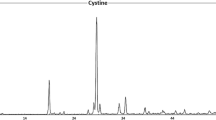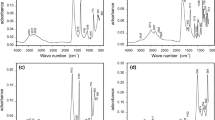Abstract
An area with extremely high incidence of urinary calculi was investigated in the view of identifying the relationship between the disease prevalence and the drinking water geochemistry. The prevalence of the kidney stone disease in the selected Padiyapelella–Hanguranketa area in Central Highlands of Sri Lanka is significantly higher compared with neighboring regions. Drinking water samples were collected from water sources that used by clinically identified kidney stone patients and healthy people. A total of 83 samples were collected and analyzed for major anions and cations. The anions in the area varied in the order HCO3 − > Cl− > SO4 2− > NO3 − and cations varied in the order Ca2+ > Mg2+ > Na+ > K+ > Fe2+. The dissolved silica that occurs as silicic acid (H4SiO4) in natural waters varied from 8.8 to 84 mg/L in prevalence samples, while it was between 9.7 and 65 mg/L for samples from non-prevalence locations. Hydrogeochemical data obtained from the two groups were compared using the Wilcoxon rank-sum test. It showed that pH, total hardness, Na+, Ca2+ and Fe2+ had significant difference (p < 0.005) between water sources used by patients and non-patients. Elemental ratio plots, Gibbs’ plot and factor analysis indicated that the chemical composition of water sources in this area is strongly influenced by rock–water interactions, particularly the weathering of carbonate and silicate minerals. This study reveals a kind of association between stone formation and drinking water geochemistry as evident by the high hardness/calcium contents in spring water used by patients.






Similar content being viewed by others
References
Abeygunasekera, A. M. (2004). Urinary stone disease in Sri Lanka. Ceylon Medical Journal, 49(2), 41–43.
Ahsan, H., Chen, Y., Parvez, F., Zablotska, L., Argos, M., Hussain, I., et al. (2006). Arsenic exposure from drinking water and risk of premalignant skin lesions in Bangladesh: Baseline results from the Health Effects of Arsenic Longitudinal Study. American Journal of Epidemiology, 163(12), 1138–1148.
APHA, AWWA, & WEF. (2012). Standard methods for the examination of water and wastewater (22nd ed.). Washington, DC: American Public Health Association, American Water Works Association, Water Environment Federation.
Appelo, C. A. J., & Postma, D. (2005). Geochemistry, groundwater and pollution (2nd ed.). Rotterdam: Balkema.
Basiri, A., Shakhssalim, N., Khoshdel, A. R., Pakmanesh, H., & Radfar, M. H. (2011). Drinking water composition and incidence of urinary calculus. Iranian Journal of Kidney Diseases, 5(1), 15–20.
Bellizzi, V., De Nicola, L., Minutolo, R., Russo, D., Cianciaruso, B., Andreucci, M., et al. (1999). Effects of water hardness on urinary risk factors for kidney stones in patients with idiopathic nephrolithiasis. Nephron, 81, 66–70.
Chandrajith, R., Wijewardana, G., Dissanayake, C. B., & Abeygunasekara, A. (2006). Biomineralogy of human urinary calculi (kidney stones) from some geographic regions of Sri Lanka. Environmental Geochemistry and Health, 28(4), 393–399.
Churchill, D., Bryant, D., Fodor, G., & Gault, M. H. (1978). Drinking water hardness and urolithiasis. Annals of Internal Medicine, 88(4), 513–514.
Churchill, D. N., Maloney, C. M., Bear, J., Bryant, D. G., Fodor, G., & Gault, M. H. (1980). Urolithiasis—a study of drinking water hardness and genetic factors. Journal of Chronic Diseases, 33(11), 727–731.
Dalton, M. G., & Upchurch, S. B. (1978). Interpretation of hydrochemical facies by factor analysis. Groundwater, 16(4), 228–233.
Davis, J. C. (2002). Statistical and data analysis in geology (3rd ed.). New York, NY: Wiley.
Dissanayake, C. B. (1979). Geochemical provinces and the incidence of dental diseases in Sri Lanka. Science of the Total Environment, 13(1), 47–53.
Dissanayake, C. B. (1991). The fluoride problem in the ground water of Sri Lanka—environmental management and health. International Journal of Environmental Studies, 38(2–3), 137–155.
Dissanayake, C. B. (2005). Of stones and health: Medical geology in Sri Lanka. Science, 309(5736), 883–885.
Dissanayake, C. B., & Chandrajith, R. L. R. (1996). Iodine in the environment and endemic goitre in Sri Lanka. Geological Society, 113(1), 213–221.
Dissanayake, C. B., & Chandrajith, R. (1999). Medical geochemistry of tropical environments. Earth-Science Reviews, 47(3), 219–258.
Dissanayake, C. B., & Chandrajith, R. (2009). Introduction to medical geology—focus on tropical environment. Heidelberg: Springer.
Finkelman, R. B., Centeno, J. A., & Selinus, O. (2005). The emerging medical and geological association. Transactions of the American Clinical and Climatological Association, 116, 155–165.
Fordyce, F. (2007). Selenium geochemistry and health. Ambio, 36(1), 94–97.
Fordyce, F. M., Johnson, C. C., Navaratna, U. R. B., Appleton, J. D., & Dissanayake, C. B. (2000). Selenium and iodine in soil, rice and drinking water in relation to endemic goitre in Sri Lanka. Science of the Total Environment, 263(1), 127–141.
Garrels, R. M. (1967). Genesis of some groundwaters from igneous rocks. In P. H. Abelson (Ed.), Researches in Geochemistry (pp. 405–421). New York, NY: Wiley.
Gibbs, R. J. (1970). Mechanisms controlling world water chemistry. Science, 170(3962), 1088–1090.
Green, S., & Salkind, N. (2005). Using SPSS for Windows and Macintosh: Understanding and analysing data (p. 448). Upper Saddle River, NJ: Prentice-Hall.
Helsel, D. R., & Hirsch, R. M. (2002). Statistical methods in water resources techniques of water resources investigations, Book 4, chapter A3. USA: U.S. Geological Survey.
Hem JD (1985) Study and interpretation of the chemical characteristics of natural water, vol 2254. US Geological Survey, Water Supply Paper 1779B. Department of the Interior. 264 pp.
Howard, J. E., & Thomas, W. C. (1968). Control of crystallization in urine. The American Journal of Medicine, 45(5), 693–699.
Johnson, C. C., Breward, N., Ander, E. L., & Ault, L. (2005). G-BASE: Baseline geochemical mapping of Great Britain and Northern Ireland. Geochemistry: Exploration, Environment, Analysis, 5(4), 347–357.
Karim, M. D. M. (2000). Arsenic in groundwater and health problems in Bangladesh. Water Research, 34(1), 304–310.
Kronberg, B. I., Fyfe, W. S., Leonardos, O. H., & Santos, A. M. (1979). The chemistry of some Brazilian soils: Element mobility during intense weathering. Chemical Geology, 24(3), 211–229.
Lax, K., & Selinus, O. (2005). Geochemical mapping at the Geological Survey of Sweden. Geochemistry: Exploration, Environment, Analysis, 5(4), 337–346.
Levander, O. A. (1987). A global view of human selenium nutrition. Annual Review of Nutrition, 7(1), 227–250.
Liu, C.-W., Lin, K.-H., & Kuo, Y.-M. (2003). Application of factor analysis in the assessment of groundwater quality in a blackfoot disease area in Taiwan. Science of the Total Environment, 313(1), 77–89.
Lloyd, J. W., & Heathcote, J. A. A. (1985). Natural inorganic hydrochemistry in relation to ground water. Oxford, England: Clarendon Press.
López, M., & Hoppe, B. (2010). History, epidemiology and regional diversities of urolithiasis. Pediatric Nephrology, 25(1), 49–59.
Meybeck, M. (1987). Global chemical weathering of surficial rocks estimated from river dissolved loads. American Journal of Science, 287, 401–428.
Mirzazadeh, M., Nouran, M. G., Richards, K. A., & Zare, M. (2012). Effects of drinking water quality on urinary parameters in men with and without urinary tract stones. Urology, 79(3), 501–507.
Oren, O., Yechieli, Y., Böhlke, J. K., & Dody, A. (2004). Contamination of groundwater under cultivated fields in an arid environment, central Arava Valley, Israel. Journal of Hydrology, 290(3), 312–328.
Piper, A. M. (1944). A graphic procedure in the geochemical interpretation of water-analyses. Transactions American Geophysical Union, 25(6), 914–928.
Plant, J., Smith, D., Smith, B., & Williams, L. (2001). Environmental geochemistry at the global scale. Applied Geochemistry, 16(11), 1291–1308.
Rajmohan, N., & Elango, L. (2004). Identification and evolution of hydrogeochemical processes in the groundwater environment in an area of the Palar and Cheyyar River Basins, Southern India. Environmental Geology, 46(1), 47–61. doi:10.1007/s00254-004-1012-5.
Robertson, W. G. (1990). Epidemiology of urinary stone disease. Urological Research, 18(1), S3–S8.
Shuster, J., Finlayson, B., Scheaffer, R., Sierakowski, R., Zoltek, J., & Dzegede, S. (1982). Water hardness and urinary stone disease. The Journal of Urology, 128(2), 422–425.
Sierakowski, R., Finlayson, B., & Landes, R. (1979). Stone incidence as related to water hardness in different geographical regions of the United States. Urological Research, 7(3), 157–160.
Singh, P., Barjatiya, M., Dhing, S., Bhatnagar, R., Kothari, S., & Dhar, V. (2001). Evidence suggesting that high intake of fluoride provokes nephrolithiasis in tribal populations. Urological Research, 29(4), 238–244.
Stites, W., & Kraft, G. J. (2001). Nitrate and chloride loading to groundwater from an irrigated north-central US sand-plain vegetable field. Journal of Environmental Quality, 30(4), 1176–1184.
Stumm, W., & Morgan, J. J. (2013). Aquatic chemistry: Chemical equilibria and rates in natural waters, (Vol. 126, 3rd edn). New York, NY: Wiley.
Subramani, T., Rajmohan, N., & Elango, L. (2010). Groundwater geochemistry and identification of hydrogeochemical processes in a hard rock region, Southern India. Environmental Monitoring and Assessment, 162(1–4), 123–137.
Tekin, A., Tekgul, S., Atsu, N., Sahin, A., Ozen, H., & Bakkaloglu, M. (2000). A study of the etiology of idiopathic calcium urolithiasis in children: Hypocitruria is the most important risk factor. The Journal of Urology, 164(1), 162–165.
WHO. (2008). Guidelines for drinking-water quality (Vol. 1, 3rd edn). Geneva: World Health Organization.
Wijayarathna, K. S. N., & Abeygunasekera, A. M. (2013). Pathogenesis of nephrolithiasis. Sri Lanka Journal of Surgery, 31(3), 28–32.
Acknowledgments
University of Peradeniya has made this study possible through University Research Grant (RG/2013/12/M) offered to UR. Dr. (Mrs.) Hemalika Abeysundara of Department of Statistics and Computer Science, University of Peradeniya, is acknowledged for her suggestions in statistical analysis.
Author information
Authors and Affiliations
Corresponding author
Ethics declarations
Conflict of interest
The authors declare that there is no conflict of interest in the content of the paper.
Ethical approval
Ethical approval for the research work has been obtained from the Faculty of Medicine, University of Peradeniya, Sri Lanka.
Rights and permissions
About this article
Cite this article
Abeywickarama, B., Ralapanawa, U. & Chandrajith, R. Geoenvironmental factors related to high incidence of human urinary calculi (kidney stones) in Central Highlands of Sri Lanka. Environ Geochem Health 38, 1203–1214 (2016). https://doi.org/10.1007/s10653-015-9785-x
Received:
Accepted:
Published:
Issue Date:
DOI: https://doi.org/10.1007/s10653-015-9785-x




